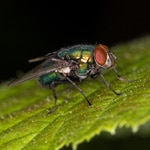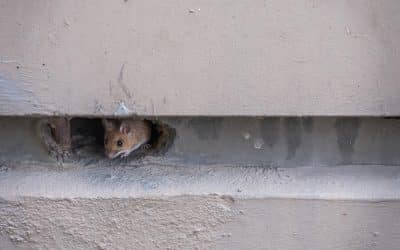
Pest Identification: Blow Flies
Blow flies are one of the most commonly seen insects around the world. Their green, blue, purple or coppery color is distinctive. They are usually the first to arrive when an animal dies, especially if it was bleeding. The presence of large numbers of blow flies in structures usually indicates an animal has died in or under the structure or chimney.
Worldwide the blow fly family includes over 1000 species. Blow fly species are found throughout all regions of the world from the poles to the equator. Common names for blow flies include bluebottle, greenbottle, black blow flies or carrion flies.
They often infest wounds of sheep, goats, cattle, and other animals. Adult blow flies are attracted to nectar, carrion, garbage, and other refuse and soggy, bloody or soiled hair, fur, or wool. As a rule, most blow fly larvae do not attack healthy tissue.
In general, each female blow fly deposits thousands of eggs over her 2- to 8-week life span. Egg masses may consist of 40 to over 1,000 eggs, but the larger masses are usually the result of oviposition by several females at the same location. Incubation may last 4 to 4.5 days, but hatching usually occurs in less than 24 hours when conditions are warm and humid.
Depending on temperature and the substrate upon which they are feeding, maggots usually complete development in 4 to 10 days. At the end of this period, larvae typically burrow in the upper centimeters of the soil and pupate for up to a week. Adult flies emerge make their way to the soil surface. About 1 week later, females begin to deposit eggs and the life cycle is repeated. Blow flies usually develop from egg to adult in only 10 to 25 days and complete 4 to 8 generations each year.
When flies are an issue, the source must be found and removed, and then it is just a matter of killing off the adult flies.

Buzzwords
5 Things in Your Home That Are Secretly Attracting Mice
When mice show up in your home, it might feel like you’ve been randomly selected. But you’re not. Most homes unintentionally offer everything a mouse needs to survive: food, warmth, shelter, and a safe place to nest. Even homes that are clean and well-maintained can...
Give Your House a Winter Check-Up and Keep Pests, Mice, and Wildlife Out
Winter is officially here, and while you’re getting yourself ready for the cold, don’t forget your home needs a little winter prep, too. Think of it like your home’s annual check-up: a quick once-over to make sure everything is in good shape before pests start looking...
How Mice Sneak Into Your Home (And What You Can Do About It)
Your home feels extra cozy in the winter, with warm blankets, soft lighting, and maybe even a fire on chilly nights. But while you’re settling in, mice are out there searching for a warm place to hide. For many Massachusetts homeowners, that means your house is at...



